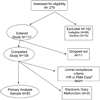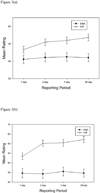The accuracy of pain and fatigue items across different reporting periods
- PMID: 18455312
- PMCID: PMC2617790
- DOI: 10.1016/j.pain.2008.03.024
The accuracy of pain and fatigue items across different reporting periods
Abstract
The length of the reporting period specified for items assessing pain and fatigue varies among instruments. How the length of recall impacts the accuracy of symptom reporting is largely unknown. This study investigated the accuracy of ratings for reporting periods ranging from 1 day to 28 days for several items from widely used pain and fatigue measures (SF36v2, Brief Pain Inventory, McGill Pain Questionnaire, Brief Fatigue Inventory). Patients from a community rheumatology practice (N=83) completed momentary pain and fatigue items on average of 5.4 times per day for a month using an electronic diary. Averaged momentary ratings formed the basis for comparison with recall ratings interspersed throughout the month referencing 1-day, 3-day, 7-day, and 28-day periods. As found in previous research, recall ratings were consistently inflated relative to averaged momentary ratings. Across most items, 1-day recall corresponded well to the averaged momentary assessments for the day. Several, but not all, items demonstrated substantial correlations across the different reporting periods. An additional 7 day-by-day recall task suggested that patients have increasing difficulty actually remembering symptom levels beyond the past several days. These data were collected while patients were receiving usual care and may not generalize to conditions where new interventions are being introduced and outcomes evaluated. Reporting periods can influence the accuracy of retrospective symptom reports and should be a consideration in study design.
Figures






References
-
- Anderson KO, Getto CJ, Mendoza TR, et al. Fatigue and sleep disturbance in patients with cancer, patients with clinical depression, and community-dwelling adults. J Pain Symptom Manage. 2003;25:307–318. - PubMed
-
- Broderick JE, Stone AA, Calvanese P, Schwartz JE, Turk DC. Recalled pain ratings: a complex and poorly defined task. Journal of Pain. 2006;7:142–149. - PubMed
-
- Cleeland C. Pain assessment in cancer. In: Osoba E, editor. Effect of cancer on quality of life. Boca Raton, Florida: CRC Press; 1991.
-
- Cleeland CS, Ryan KM. Pain assessment: Global use of the Brief Pain Inventory. Ann Acad Med Singapore. 1994;23:129–138. - PubMed
-
- Daut RL, Cleeland CS. The prevalence and severity of pain in cancer. Cancer. 1982;50:1913–1918. - PubMed
Publication types
MeSH terms
Grants and funding
LinkOut - more resources
Full Text Sources
Medical
Research Materials
Miscellaneous

